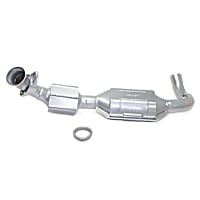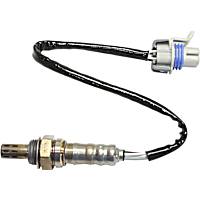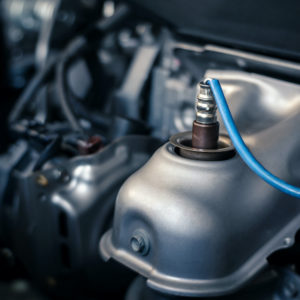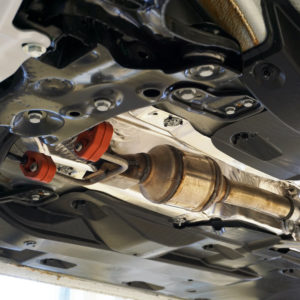Your vehicle’s powertrain control module (PCM) relies on oxygen sensors to adjust engine performance and control emission levels. When the oxygen (O2) sensor that monitors the exhaust from the catalytic converter stops working, the PCM may log the diagnostic code P0140.
What Does the P0140 Code Mean?
Diagnostic trouble code (DTC) stands for “Oxygen Sensor Circuit No Activity Detected (Bank 1, Sensor 2).” It indicates that the PCM perceives a problem with the post-catalytic monitoring oxygen sensor (the bank 1, sensor 2) circuit.

Found behind the catalytic converter, this sensor measures the oxygen levels in the exhaust after the converter breaks down the unburned fuel.
If the catalytic converter is in good condition, this oxygen sensor takes more time to change its voltage than the #1 sensor placed before the catalytic converter. Code P0140 will be set when the downstream O2 sensor’s signal remains within a certain range for longer than specified.
To learn more about how DTCs like P0140 are stored due to signals communicated by oxygen sensors, read our technical explanation about O2 sensors and OBD codes. If you want to quickly learn the possible causes of P0140, continue reading the next section.
Note: Code P0316 is a generic code specified by the Society of Automotive Engineers (SAE). Depending on the car manufacturer, the code’s definition may change.

What are the Possible Causes of the P0140 Code?
You can narrow down the cause of the code P0140 to several possibilities. They include:
- Failed oxygen sensor
- Rear oxygen sensor wiring or connection issues
- Faulty PCM or software in need of an update

Note on Malfunctioning O2 Sensors
If the O2 sensor isn’t reacting at all, it can be due to a dead sensor, a shorted or severed O2 signal wire, or, in some cases, it can be due to a bad O2 reference ground. Conventional O2 sensors have four wires: the two heater wires (one of which is grounded by the ECM/PCM to control the heater). Also, if there has been coolant in the exhaust, or silicone spray on the O2 sensor, those chemicals can coat the O2 sensor and render it inactive.
And then there are the two O2 sensor signal wires: one is a reference ground and the other is the actual O2 signal wire. If the reference ground wire or its terminal is compromised (open circuit), the actual voltage on the O2 sensor will usually read very high (2.4 volts or more) but the ECM/PCM will interpret the sensor input as lean due to the open reference ground.
What are the Common Symptoms of the P0140 Code?
Common warning signs of a P0140 code include:
- Illuminated or blinking check engine light
- Increased tailpipe emissions
- Failed vehicle emissions test
Fortunately, most instances of a P0140 code don’t hamper the drivability of the car. The post-catalytic oxygen sensor only keeps an eye on the catalytic converter’s efficiency. In most vehicles, the PCM doesn’t use the data from this sensor as a primary input for adjusting the fuel sent to the engine.
However, you should still bring your car to a trusted auto repair shop if your scanner shows code P0140. Your vehicle’s emission levels may exceed the limits set by state and federal laws, which can cause your car to fail an emissions test.
How to Diagnose the P0140 Code
Learning how to diagnose and repair engine code P0140 can prove a handful. The videos below can help guide you through the diagnosis:
How to Fix the P0140 Code
Even though the symptoms, causes, and affected systems of OBD-II codes tend to overlap, there is no one-size-fits-all repair for them. The process for diagnosis and repair may vary based on the vehicle’s make and model. Let your mechanic take care of the P0140 code for a guaranteed fix.
If you are confident with your automotive knowledge and skills, the first step is to accurately pinpoint what triggered the P0140 code. Then, using online auto repair resources and guides, identify the most effective way to resolve the issue.
Supplement your task with an ALLDATA single-vehicle subscription to benefit from comprehensive and up-to-date factory repair information. Also, check your owner’s manual before implementing the solution to ensure it’s the right one for your vehicle.
Oxygen Sensors and OBD Codes
The ECM/PCM depends on the O2 sensor to provide after-the-fact information regarding combustion efficiency so that the injector pulse width can be fine-tuned on the fly for peak emission control. When the ECM/PCM is using the O2 signal it is operating in a mode called “closed loop” fuel control. “Open loop” strategy is used by the ECM/PCM when the engine is cold or at wide open throttle, or if a problem is detected in the fuel system that makes closed loop operation unreliable or inefficient.
The downstream O2 sensor keeps track of how well the catalytic converter stores oxygen. If it is tracking closely with the upstream sensor, the catalyst isn’t working right and a code is stored. But the downstream O2 sensor typically reads with a lazy signal; if that signal flatlines, the downstream O2 sensor has a problem of some kind.
For more technical information on how oxygen sensors work, you can read our discussion here.
Getting a New Oxygen Sensor That Fits Your Vehicle
Aside from triggering the P0140 code, a faulty oxygen sensor can also cause higher emission levels, which can lead to a failed vehicle emissions test. We all know how much of a hassle it is to retake an emissions test, so it’s best to replace your oxygen sensor before that happens. Luckily, getting a brand-new oxygen sensor is fast and easy with CarParts.com.
At CarParts.com, you’ll find a wide selection of oxygen sensors, sourced from only the most trusted manufacturers in the industry. If you’re on a strict budget, don’t worry. We offer sensors at different price points, so you’re sure to get the most bang for your buck when you order from us. Should you need any help, don’t hesitate to ask our customer service staff who are available 24/7.
Don’t wait until you fail your next emissions test before fixing your vehicle’s P0140 code. Check out our catalog of high-quality oxygen sensors at CarParts.com and order one today!
Products Mentioned in this Guide
Any information provided on this Website is for informational purposes only and is not intended to replace consultation with a professional mechanic. The accuracy and timeliness of the information may change from the time of publication.



 Catalytic Converter
Catalytic Converter
 Oxygen Sensor
Oxygen Sensor
















